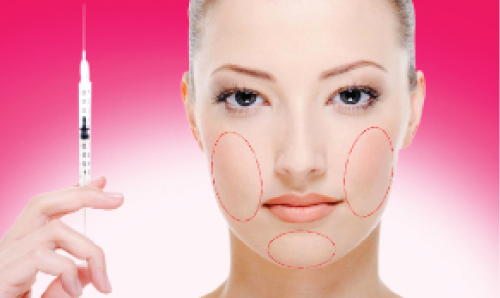

CHIN/CHEEK AUGMENTATION
Full, defined cheeks are a sign of youth and beauty, but over time the face loses fat, causing the cheeks to become flat and saggy, giving way to a sunken-in look. Although some are born with naturally high cheekbones, achieving the look of sculpted cheeks can be accomplished through both nonsurgical and surgical treatments that focus on restoring plumpness, volume and definition. To restore volume to the midface and recreate youthful contours, your doctor may suggest facial implants, fillers or fat grafting.
FAT GRAFTING AND TRANSFER
Using your own fat (taken from another part of the body, like the hips or butt), your plastic surgeon can give you fuller, plumper cheeks. Fat transfer is probably the most popular option at the moment for long-term cheek fullness, but using your own fat requires an additional liposuction-like procedure to be performed.
CHEEK IMPLANTS
Along with fat grafting, cheek implants are another option for restoring youthfulness more permanently. Silicone implants, ideal for someone who wants to add a lot of volume as opposed to a slight increase, add fullness and create a lifting effect.

FILLERS AND INJECTABLES
To restore volume lost with age or to provide definition, your plastic surgeon or dermatologist can inject fillers along the cheekbone. While there are a variety of injectables available, different ones produce varying effects—and not all of them last the same amount of time.
“Technically, there are no fillers approved by the FDA for use in this area, but there are several options that are considered to be safe and effective,” explains Plano, TX, facial plastic surgeon D.J. Verret, MD. For temporary correction, Dr. D.J. Verret suggests hyaluronic acid fillers like Restylane and Juvéderm, as well as collagen-stimulators Radiesse.
CHIN AUGMENTATION
Chin augmentation using surgical implants can alter the underlying structure of the face, providing better balance to the facial features. The specific medical terms mentoplasty and genioplasty are used to refer to the reduction and addition of material to a patient’s chin. This can take the form of chin height reduction or chin rounding by osteotomy, or chin augmentation using implants.
This operation is often, but not always, performed at the time of rhinoplasty to help balance the facial proportions. Chin augmentation may be achieved by manipulation of the jaw bone (mandible) and augmentation utilizing this technique usually provides a more dramatic correction than with the use of prosthetic implants.
Chin implants are to build a better profile.Patients’ own bone is donated from ribs and from part of the pelvis (the ilium.) Unfortunately, use of donated bone implants in chin augmentation, even the patient’s own, appears to be associated with a higher rate of infection, even after the implant has been in place for decades.
Chin augmentation is still popular because it’s a relatively easy operation for the patient while producing noticeable changes in the silhouette of the face. This type of surgery is usually performed by an oral and maxillofacial surgeon, otolaryngologist, or plastic surgeon.